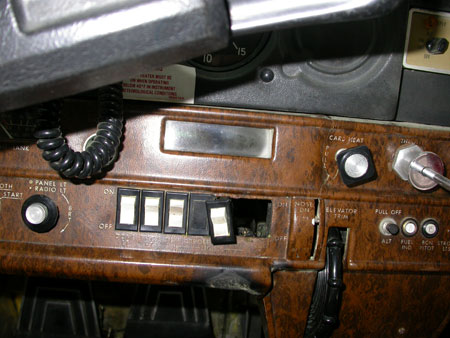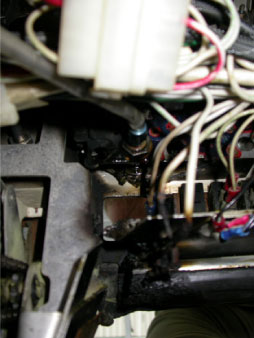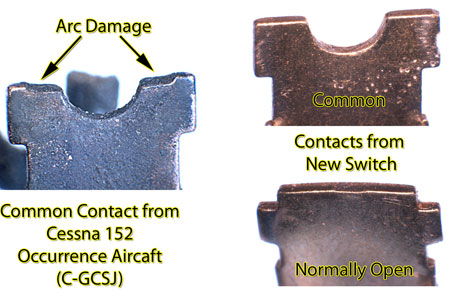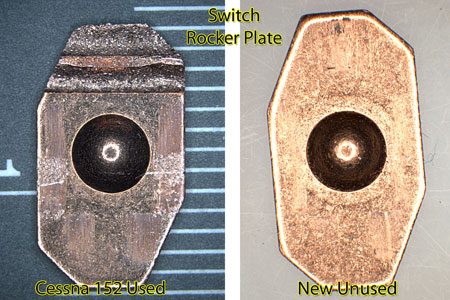In-Flight Fire
Canadian Flight Academy Limited
Cessna 152 C-GCSJ
Oshawa, Ontario
The Transportation Safety Board of Canada (TSB) investigated this occurrence for the purpose of advancing transportation safety. It is not the function of the Board to assign fault or determine civil or criminal liability. This report is not created for use in the context of legal, disciplinary or other proceedings. See Ownership and use of content. Masculine pronouns and position titles may be used to signify all genders to comply with the Canadian Transportation Accident Investigation and Safety Board Act (S.C. 1989, c. 3).
Summary
The Cessna 152 aircraft (registration C-GCSJ, serial number 15284043) took off from the Oshawa Municipal Airport destined for Kingston, Ontario, with the pilot and one passenger on board. At approximately 1510 eastern daylight time, just after clearing the Oshawa control zone, the pilot and passenger noticed an electrical odour and observed a small fire and smoke emanating from the bottom of the lower left instrument panel where the aircraft lighting switches were located.
The passenger sitting in the right front seat reached for and discharged the fire extinguisher. The fire was quickly extinguished; however, the extinguishing agent and smoke clouded the cockpit, reducing visibility. Both cockpit side windows were opened and visibility improved considerably. The aircraft returned to the Oshawa Airport and landed without further incident. The pilot suffered a minor burn to the leg.
Factual information
History of the Flight
The aircraft took off at approximately 1500 eastern daylight timeFootnote 1 and proceeded on an easterly heading towards Bowmanville, Ontario. The pilot left the landing light on after take-off with the intention of shutting it off after the aircraft was approximately five nautical miles (nm) east of Bowmanville.
As the aircraft flew by Bowmanville, the pilot and passenger detected an electrical burning odour. Approximately 10 seconds later, sparks were observed coming from underneath the lower left instrument panel. The pilot immediately turned back towards the Oshawa Airport and contacted the tower to advise them of their situation. The tower controller requested that the pilot call the tower at a recognizable landmark near the airport. After completing the transmission, the pilot switched off all of the electrical switches including the master switch. The pilot and passenger then observed small flames emanating from the bottom of the lower left instrument panel. The flames ignited the plastic instrument panel (see Photo 1).
The passenger immediately reached for and activated the fire extinguisher which successfully extinguished the flames. The cabin vents were closed at the time of the event. After the extinguisher was discharged, the visibility within the cabin was poor. The pilot and passenger opened the two side windows to clear the smoke and extinguishing agent quickly, bringing visibility back to normal. The cabin vents were not opened but were not required as visibility within the cabin improved.
As the aircraft lined up on final for Runway 22, the pilot selected the master switch back to ON to extend the flaps for landing, and then immediately turned the master switch to OFF. The aircraft landed without further incident and taxied onto Bravo taxiway where the aircraft engine was shut down. Maintenance examined the landing light circuit to assess the damage and found that the landing light circuit breaker did not trip during the entire event.
Meteorological Information
Visual meteorological conditions (VMC) existed at the time of the occurrence. The 1400 automatic terminal information service (ATIS) for the Oshawa Airport was broadcast as wind 200° True (T) at 5 to 10 knots, visibility and sky condition CAVOK,Footnote 2 altimeter 30.16 inches of mercury (Hg).
Personnel Information
The pilot and passenger were both enrolled at the Canadian Flight Academy Limited for flight training. They had received their private pilot licences and were currently enrolled for their commercial pilot training. The pilot-in-command was certified and qualified for the flight in accordance with existing regulations. At the time of the occurrence, the pilot had acquired a total flying time of 190 hours of which 187 hours were obtained on the same aircraft type.
Aircraft Information
Records indicate that the aircraft was certified, equipped, and maintained in accordance with existing regulations and approved procedures. No previous defects were reported with the landing light circuitry and the ground run-up before the flight revealed no anomalies with the electrical system.
Landing Light Circuit
The landing light circuit is composed of a 15-amp, push-to-reset type circuit breaker connected in series with a single pole, single throw rocker switch connected to a 28 VDC (volt direct current) 250-watt incandescent lamp. The landing light switch and circuit breaker are located on the lower portion of the left instrument panel.
Oil Indicating System
Mounted directly above the landing light switch are the engine oil pressure and temperature gauges. The oil pressure gauge is connected to an oil-carrying pressure line directly connected to the engine. This type of circuit and instrument panel layout is common amongst the 100 series Cessna aircraft.
TSB Engineering Laboratory Examination
The following parts were removed from the aircraft and shipped to the TSB Engineering Laboratory for testing and evaluation:
| Part Description | Manufacturer | Cessna Part No. |
|---|---|---|
| 1. Landing light switch | Unknown | Unknown |
| 2. Used landing light switch | Carling Technologies | C906-5 |
| 3. Landing light 15-amp circuit breaker | Wood Electric Corp. | S-1360-15L |
| 4. Oil pressure and temperature gauges | Stewart-Warner | 2646-00053 6246-00370 |
| 5. Lower cover instrument panel | Unknown | 0413559-3 |
| 6. Landing light wire harness | Unknown | Unknown |
Occurrence Landing Light Switch Examination
The landing light switch showed evidence of melt damage beginning at the base and progressing upward on both sides. The same damage was evident on the interior of the switch. The switch exterior had a thick coating of dust and an oily residue that was also found inside the switch. A scanning electron microscope (SEM) and energy dispersive spectroscopy (EDS) analysis of the residue indicated that it may have been engine oil. Due to the nature of the tests, positive identification of the residue could not be determined.
The rocker switch's common contact was the only metallic part recovered. It appeared to have been extracted from the switch casing as the casing was melting. The landing light circuit wires remained attached to the contact but showed evidence of fire damage near where the contact enters the switch. The contact was coated with the plastic casing material and showed evidence of repeated arcing which severely eroded the contact's surface (see Photo 2).
Effects of Arcing
Arcing produces very high temperatures and is dependent upon the applied voltage and current. Typically, switch arcing, a phenomenon common to most switches, is of limited duration and isolated to small areas. The occurrence switch was wired such that it directly controlled the 250-watt incandescent lamp. According to the United States Federal Aviation Administration (FAA) Advisory Circular 43.13-1B (pages 11-16), this type of lamp can have an initial current up to 15 times the continuous current needed to remain on. This is because the cold filament has a lower resistance than a hot filament, thus the initial current could be as high as 134 amps, resulting in intense arcing. The only restriction would be the current limitations of the power source. Every time the landing light switch was selected to ON, the electrical current would produce an arc that, with repeated use, would erode the areas where the arc contacted the switch's copper components (see Photo 3). The fit between those components would be affected to the point where continuous arcing could occur even under normal loads.
The heat produced by arcing also promotes oxidization of the copper components, thus increasing their resistivity and producing even more heat. The heat produced would reach a level where the internal lubricant used to prevent oxidation and provide for smooth switch operation would deteriorate, thus leading to more oxidation. The cycle could continue until the heat produced would be sufficient to melt the switch casing. The switch's contacts, which are supported in place by the casing, could become dislodged or be pulled free from the switch and result in a live wire being exposed.
Used Landing Light Switch Examination
A used landing light switch removed from another aircraft when it was faulted as difficult to toggle was sent to the TSB Engineering Laboratory for examination. It was identical in composition and structure to the occurrence switch. Although it required extra effort to toggle, it was functional. A subsequent internal examination of the switch revealed a lack of lubricant within the switch which may have explained the stiffness of operation. The copper rocker plate showed evidence of erosion due to arcing and rubbing (see Photo 4). There was also evidence of severe oxidation around the areas where arcing damage was evident. The used switch was provided to determine what the temperature value of the exposed switch contacts was when continuous electrical power was applied over a period of time. An electrical load similar to the 250-watt lamp, connected to a 28 VDC power supply, was used and after a period of three hours the temperature reading at the contacts was an acceptable 53.5°C.
Current Federal Aviation Administration and Switch Manufacturer Recommendations
According to the FAA Advisory Circular 43.13-1B (pages 11-17), because of the initial current encountered by switches controlling 28 VDC lamp loads (incandescent lamps), the switches should have a derating factor of 8. This aircraft's switch controls a 250-watt lamp in a circuit powered by 28 VDC and should have a minimum DC current rating of 71 amps. Carling Technologies, the switch manufacturer, was contacted and provided with the landing light circuit and switch information. The manufacturer was provided the following information: the switch is a TLG-series rocker switch with a rating of 10-amp 250 VAC (volt alternating current), 15-amp 125 VAC, 3/4 HP 125-250 VAC. The aircraft circuit is a DC circuit (28 VDC 250-watt lamp). After evaluating this information, the manufacturer reported that the switch was not designed to control the lamp loads described. The FAA's advisory circular also has a warning that states "Do not use AC derated switches in DC circuits. AC switches will not carry the same amperage as a DC switch."
Wiring Harness
The wires from the aircraft's landing light circuit were identified as 16 American wire gauge (AWG) labelled with the MIL Specification M5086/1-16-9. The 16 AWG wire is rated for applications up to 15 amps. This exceeds the steady-state current draw of 8.9 amps for this circuit. Although lamp loads can exceed 15 times their rated current for a short duration, examination of the wire indicated no evidence of damage due to excessive current. Thus the wire harness was considered to be suitable for the circuit.
Circuit Breaker
The circuit breaker (CB) was identified as a Wood Electric 15-amp, push-to-reset circuit breaker, Cessna part number S1360-15L. The purpose of the circuit breaker in the circuit is to protect the circuit wiring, not the components attached to the wiring. The 15-amp, thermal type CB was found to be suitable for the circuit. The CB did not trip after the occurrence. By design, these CBs do not react instantaneously to an over-current condition. This feature is necessary because when the light switch is selected to ON, the initial current can be as high as 15 times its rated load. If the CB was to react instantly to the initial current, it would trip every time the switch was selected to ON.
Features and Examination of the Circuit Breaker
The CB incorporates a bimetallic strip that reacts to an over-current condition. The strip acts as a normally closed switch and will remain closed until the CB current rating is exceeded. When the CB's current rating is exceeded, the bimetallic strip will heat up, causing it to curl, which breaks the contact and opens the circuit. The CB was tested by connecting it to a 12 VDC aircraft battery. The test resulted in a tripped CB that could not be reset. The CB was disassembled to determine if an internal fault prevented its operation. During the examination, it was noted that portions of the bimetallic strip had melted.
The plastic components of the CB showed minimal heat damage, thus the bimetallic strip melted due to heat generated from within the strip and not externally. Research into battery outputs revealed that aircraft batteries can supply a short circuit current in excess of 1800 amps. Directly connecting the CB to the battery during testing may have resulted in the CB being subjected to a high current flow that resulted in high temperatures which exceeded the limitations of the CB's bimetallic strip.
Fire Propagation
Arcing within the landing light switch could have provided the ignition source necessary for a fire to start. The dust on the switch, coupled with the oil residue which may have seeped from the oil pressure gauge line located above it, may have provided the kindling necessary to start a fire. The oil would consistently reach its flash pointFootnote 3 when exposed to arcing and, given its proximity, would cause the dust to ignite. The oil may have seeped from the oil pressure fitting for a period of time and not necessarily on this flight.
A small section of the plastic instrument panel was tested for flammability by subjecting it to a direct flame. The piece of the panel readily ignited. The sustained flame also produced gases that were quite harsh when inhaled. The composition of the off-gases could not be tested, but TSB engineers reported having to evacuate the test area and increase ventilation as breathing became difficult.
By combining the spark (arcing of the switch), kindling (dust and oil), and the plastic panel (fuel), it was possible to duplicate the fire event encountered during the flight.
Service Difficulty Reports (SDR) Database
A search of the FAA SDR database revealed 23 events similar to this occurrence. The common terms were: smell or smoke in cockpit, landing light switch hot, landing light switch arcing, landing light switch melted, and circuit breaker did not trip.
Other Consequences of this Type of Event
The Cessna 100 series aircraft is extensively used by flight training centres and private owners worldwide. The student pilot's workload during the early stages of their flight training is high and their focus is mainly on the handling of the aircraft in a safe manner. If this type of event were to occur during a training flight, especially a solo flight, student pilots may find themselves in a situation where the focus shifts from flying the aircraft to controlling a cockpit fire. Depending on the ability of the student pilot to handle this type of situation, it may result in a loss of control of the aircraft.
Analysis
The pilot and passenger coordinated their procedures in controlling the electrical fire and clearing the cabin of smoke. While on final approach, the electrical power was turned on by selecting the master switch to ON in order to select the flaps down and then, immediately after, the master switch was turned to OFF. Not allowing the switch to remain on may have prevented the electrical fire from reigniting during a critical phase of the flight.
The landing light circuit, the circuit breaker, and the wiring harness were appropriate and could handle the electrical load. The landing light switch, however, did not have the capability to continuously operate the lamp's electrical load in a safe manner. The switch manufacturer indicated that the switch was controlling a circuit beyond its design capability. The switch was coated with dust and engine oil residue which seeped over a period of time from the oil pressure line connected to the oil pressure gauge located directly above the landing light switch. The switch arced at the contacts which increased contact deterioration over a period of time. Heat values increased within the switch to a point where the switch casing melted. Once the switch began to melt, its structural integrity was reduced and the contacts within the switch were no longer supported and eventually fell out or pulled away from the switch. Once exposed, the contacts arced, causing the oil to flash, which ignited the nearby dust. This in turn ignited the plastic instrument panel which fuelled the fire, sustaining combustion and producing gases that would be harsh to inhale. These gases would be concentrated in a small cockpit area such as that found in a Cessna 152. Opening the cockpit side windows in flight alleviated this situation and may have protected the pilot and passenger from possible incapacitation.
The following TSB Engineering Laboratory report was completed:
- LP 103/2007 – Landing Light Switch Evaluation
This report is available from the Transportation Safety Board of Canada upon request.
Findings
Findings as to causes and contributing factors
- The landing light switch installed in the occurrence aircraft was beyond its design capability and therefore was unsuitable for the circuit it was controlling.
- Excessive heat from arcing and oxidization within the switch weakened the switch structure and contact support, allowing the contacts to fall out or be exposed. Arcing from the contacts caused the oil residue to flash, which ignited a nearby dust accumulation and started the fire.
- Combustion was sustained by the plastic instrument panel.
Findings as to risk
- The contents of the gases given off by the burning plastic instrument panel could not be tested for toxicity. In an enclosed environment, breathing the fumes from a similar fire may lead to incapacitation.
- Similar landing light switch systems are incorporated on most of the Cessna 100 series aircraft, thereby increasing the likelihood of a similar event.
Other Finding
- The 15-amp circuit breaker and wiring harness were found to be appropriate for the landing light circuit.
Safety action
Safety action taken
Aviation Safety Advisory A07O0264-D1-A1
On 17 September 2008, the Transportation Safety Board of Canada (TSB) issued Aviation Safety Advisory A07O0264-D1-A1 (Landing Light Switch Failure) to Transport Canada (TC). The safety advisory indicated that TC, in coordination with the United States Federal Aviation Administration (FAA) and the aircraft manufacturer, may wish to take action to mitigate or eliminate the threat of fire caused by AC-rated switches in the landing light DC circuit of Cessna 152 aircraft.
Aviation Safety Advisory A07O0264-D2-A2
On 17 September 2008, the TSB issued Aviation Safety Advisory A07O0264-D2-A2 (Smoke in Cabin Emergency Procedures) to TC. The safety advisory indicated that TC, in concert with manufacturers and the regulatory authorities of other countries, may wish to review emergency checklist procedures dealing with smoke and fire on general aviation (GA) aircraft to include an additional step to eliminate smoke or fumes.
Cessna Aircraft Company
Cessna has reviewed the usage and service life of the landing and taxi light switches. As a result, Cessna issued revisions to the service manuals of all of its aeroplanes equipped with similar landing and taxi light switches. Issued in early 2008, the revisions add replacement requirements for the switches.
In January 2008, Cessna issued Temporary Revision Number 4 to Cessna 152 "1978 through to 1985 service manuals" that includes Special Inspection No. 26 which requires the inspection and replacement of the landing and taxi light switches. Such inspections and replacements are to take place at the next 100-hour or annual inspection and every five years thereafter.
Cessna will also be performing cyclic endurance bench tests on all switch types, including the replacement switch identified in Special Inspection No. 26. The five-year switch replacement interval may be adjusted pending the results of these bench tests.
Cessna plans to issue a "mandatory service bulletin" to have all current switches replaced at the next annual or 100-hour inspection, not only on the landing and taxi light systems, but on any other system with similar electrical loads.
This report concludes the Transportation Safety Board's investigation into this occurrence. Consequently, the Board authorized the release of this report on .



